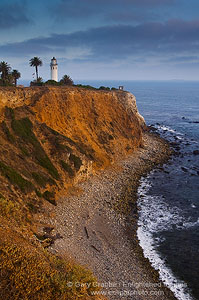 Picture: Sunset light on coastal cliffs at the Point Vicente Lighthouse, Palos Verdes Peninsula, California
Picture: Sunset light on coastal cliffs at the Point Vicente Lighthouse, Palos Verdes Peninsula, California
I just finished processing the images from my recent trip down along the Southern California coast. There was a grand total of 445 RAW image files that have been converted into 55MB Master TIFF Files. The majority of these will be moved into the next phase of production as they get ready for distribution to my stock files, agents, and edited for my current book project.
I was recently asked why process all of those images, especially if some of them will be thrown out or marked as ‘seconds’. The simple answer for doing all of this extra work upfront is that I’ll have all of my variations ready and done. The longer answer involves my having grown up editing slides on a lightbox. I edit chronologically, so if I shot something once that looked good, and it looked better later, I’d shoot it again. I’ll process all the RAW variations in order, and then later decide which I’ll keep as a main select, a second, or (toss) out. I find that doing a final edit of finished Tiffs is much easier once everything has been cleaned and color corrected. The bulk of my images take less than a couple minutes each to fully process and clean.
As an example, if I have 16 variations of a scenic lighthouse shot, I’ll process 10 RAW files of that particular scene. Then, after comparing the color corrected TIFF’s, I may keep seven as final selects, two ‘similars’ may get dfeep-filed, (archived), and one will get marked as an out and deleted.
The other main reason for doing the work upfront; If a call comes in from a client for subject XYZ, I’ll have all my verticals, horizontals, wide angles, telephotos, high horiozon, low horizon, etc. shots ready to go into a lightbox within minutes. Conversely, if I had to go back to my raw archives and look for variations, edit, process, etc., this will take a good chuck of time down the road. And if a short deadline stock request comes in while I’m already neck deep in another project, I might not be able to get the extra work done, and hence, miss a potential sale.
Moral of the story: Hours & Days of work now = only minutes of work later. I choose to take an extra 20-30% time investment upfront, and the end result is a Hard disk folder full of images that looks as good and comprehensive as a good edit of 80 rolls of film nested into a hanging file folder. And on the business side of the equation, being able to respoind to client requests quickly is key, especially if you want to be seen as a professional, and / or have them call you again.



Great shot Gary. Mine didn’t have any warmth on the cliff side.
Good to know your workflow too.
Nice photo and excellent info. I can only imagine how much quicker you’d be at this if you were using Lightroom. You’re still doing this all in Photoshop?